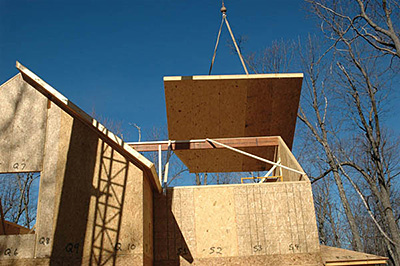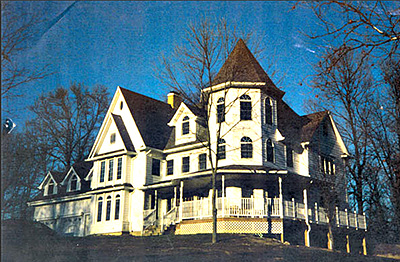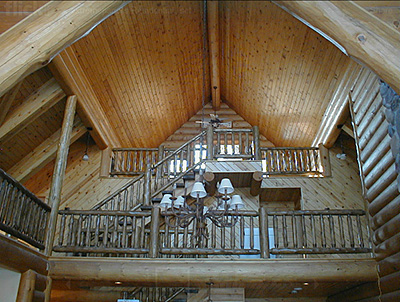The Benefits of Building with SIPs
by Rachel Lyon, Editorial Director for Direct from the Designers™
When you imagine building a new home, you probably envision pieces of lumber being raised into a skeleton that gets fleshed out with pipes, wires, insulation, and drywall. Stick framing is the most common residential building method in the United States, but more people are finding that Structural Insulated Panels (SIPs) are another totally viable and convenient option. The end results are essentially the same—you’ll have produced a beautiful home in either case—but the benefits of using SIPs start from the moment construction begins and can extend through the life of the home.
What Are SIPs?
If the traditional stick framing method is like building a house’s skeleton, Structural Insulated Panels are like building a gingerbread house, as whole walls can go up much faster. This is because SIPs are more complete building blocks; they are composed of a foam core of insulation between two structural facings, which are essentially boards of wood compressed with adhesives. SIPs combine sturdy composition and built-in energy efficiency, and they come to the building site ready-to-use so a house can be raised much more quickly.
If you want to build with SIPs, provide your house plans to a company that manufactures panelized construction. They will build your home in pieces in factory-controlled settings, and then ship them to be put together on-site. You can probably find a company in your region, but there are also some that ship worldwide, so it’s worth your time to shop around for the best deal.
Why Use SIPs?
The first benefit of SIPs is that they aren’t exposed to the elements during their construction, unlike stick framed homes, which are exposed day and night, rain and shine, until they are completed. While framing lumber is treated to resist water and is engineered for what Mother Nature can throw at it, these are not ideal conditions. The risk of rot and mold is higher the longer the frame is open, and because weather can be fickle, you can’t always avoid moisture during the course of a build. SIPs come prefabricated, greatly reducing the risk of damage and allowing you to wait until the forecast is all clear.
A house built using SIPs offers increased structural stability and accuracy. Not only are the solid building blocks inherently more sturdy, but they go up smoother and straighter and result in a structure that is truer to the blueprints. It’s no wonder why—with fewer pieces, there’s less room for error. And because there’s space for everything you need, from wiring to cutouts for windows and doors, it is much easier to fit everything into place than building it in layers and stages.
Perhaps the main thing that draws homeowners to SIPs is their superior insulating qualities. A SIP house is insulated better than a framed one, plain and simple. Performance data has shown this to be true, even with extra-insulated framed walls. SIPs are less likely to “leak,” allowing you to choose smaller heating and cooling systems for the home and saving you money through all seasons—most people can expect to save about 50% or more on these bills. Green to build and green to own, this is a method of residential construction that appeals to casual and serious environmentalists alike.
How Does Cost Compare?
When all factors are taken together, the price to build a home with SIPs is actually comparable to the price of a home built with stick framing. As with any building project, the bill varies regionally based mostly on accessibility and the cost of labor, so each case is different. The SIPs themselves obviously cost more than regular lumber, but there will be savings in labor, due to the reduced construction time, and because the amount of waste generated is negligible, meaning you get the most bang for your buck and site cleanup is a breeze. The continued savings that a SIP house offers will make up for any extra cost within a few years, and then you’re set to reap rewards for as long as you live there!
When you’re thinking about building with SIPs, you should shop for a good manufacturer as well as an experienced building crew. While the delivered product might look the same, different companies use different insulations—so ask about it and compare R-values!—and some offer metal or concrete skins instead of wooden structural facings. And while builders typically find that SIPs are easier to build with, you definitely want to make sure you hire somebody with experience. A little extra involvement from the start will earn you a smoother build and a better home in the end!
BROWSE HOME PRODUCT ARTICLES
- Creating a Spa-Like Master Bathroom »
- Designing a Water-Efficient Bathroom »
- Design a Modern Bathroom »
- View All Bathroom Articles »
- Building a New Home »
- Building a Duplex »
- Finding the Right Home Builder »
- View All Building Tips Articles »
- Adding the Right Columns»
- Decorative Touches for Your Interior»
- Shutters for Every Architectural Style »
- View All Columns & Millwork Articles »
- How to Use Specialty Laminates »
- Decorative Touches for Your Home's Interior
- View All Countertops and Surfaces Articles »
- What Goes Into a Great Deck? »
- Decorative Touches for Your Home's Interior »
- View All Decking Articles »
- Choosing Glass for Your Entry »
- Stylish Personas for Your Front Door »
- Using Sidelites and Transoms »
- View All Door Articles »
- Choose Siding for Your Region »
- Get the Most Out of Exterior Paint »
- Mixing Siding to Define Your Exterior »
- View All Exterior Articles »
- Finding the Right Home Builder »
- The Appeal of Small House Plans »
- Choosing the Perfect Floor Plan »
- View All Finding a Home Plan Articles »
- Colorful Flooring for Your Home »
- Designing With Different Widths»
- Chic, Neutral, Gray Flooring »
- View All Flooring Articles »
- Garage Doors That Add Curb Appeal »
- Caring for Your Garage Doors »
- Benefits of Insulated Garage Doors »
- View All Garage Door Articles »
- Reclaimed Products for Your Home »
- Building a Green and Stylish Home »
- Benefits of Building with SIPS »
- View All Green Building Articles »
- Cool Gadgets for Your New Home »
- Creating a Hi-Tech Home »
- Efficient Gifts for New Homeowners »
- View All Home Electronics Articles »
- Improve Your Home's Air Circulation »
- How to Improve the Air Circulation in Your Home »
- View All HVAC Articles »
- Bedrooms Designed for Sleep »
- Selecting a Fireplace for Your Home »
- Crafting a Luxurious Master Suite »
- View All Interior Design Articles »
- Design the Perfect Outdoor Space »
- Dive into a Beautiful Pool »
- Design a Sizzling Outdoor Kitchen »
- View All Outdoor Living Articles »
- Apps to Help You Pick Paint Colors »
- Create the Perfect Mood with Paint »
- How to Read the Color Wheel »
- View All Painting & Decorating Articles»
- Creating a Spa-Like Master Bathroom »
- High-Impact Kitchen Upgrades »
- Creating a Water Efficient Bathroom »
- View All Plumbing Fixtures Articles»
- Cladding That Complements Your Exterior »
- Reasons to Consider Prefinished Siding »
- View All Siding & Cladding Articles»
- All About Solar Powered Skylights »
- Natural Lighting for the Dark Corners of Your Home »
- Design a Better Bedroom with Skylights »
- View All Skylight Articles»
.png)
.png)



